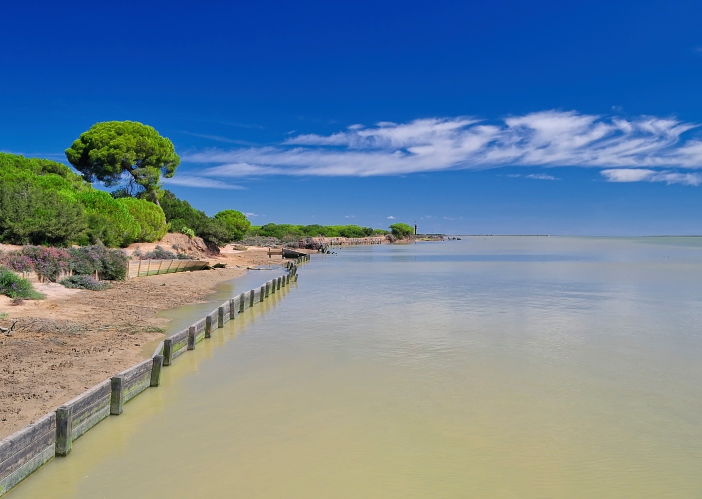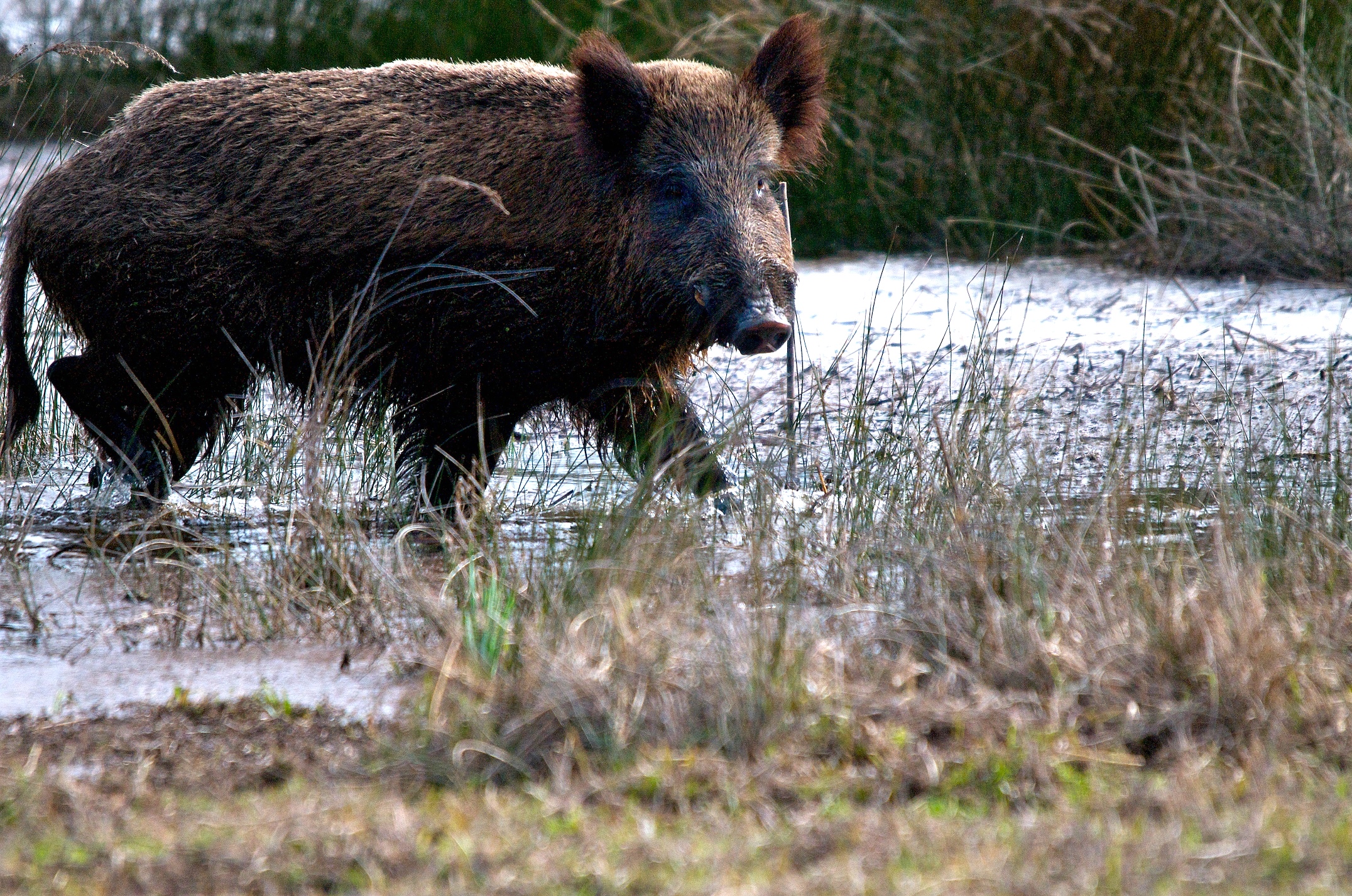The Doñana National Park is Spain's largest protected area; Europe's biggest wetland; and one of the continent's most extensive nature reserves. Doñana covers an area of 290,162 hectares (2,901.62 km²), equal in size to the province of Álava or, to put it in other terms, 0.59% of Spanish territory. To get a better idea, picture in your mind's eye an area bigger than Luxemburg, which has an area of 2,586 km2.

The Park is mostly situated in the easternmost part of Huelva province, and partly situated in the south-western part of Seville province and the north-western part of Cadiz - in an area bounded by the Huelvan coastline, the Lower Guadalquivir River and the Huelva-Seville corridor. This area encompasses fourteen municipalities belonging to three different provinces. The variety of Doñana's ecosystems and its ecological value, recognised by international agreements and conventions, have earned it undoubted international prestige as a nature reserve, which has been reflected through different designations:

National Park (1969)
Biosphere Reserve (1981)
Ramsar Area (1982)
Council of Europe Diploma for Management (1985)
Area of Special Protection for Birds [ZEPA (1988)]
Nature Park (1989)
UNESCO World Heritage Site (1994)
European Charter for Sustainable Tourism [CETS (2006)]

As for its history, we need to go back to the period between the late 13th and the 19th century, when for a very long time it was a manor, and when it was known as The Doñana Hunting Ground or, from the 16th century onwards, the estate of the House of Medina Sidonia-Villafranca (the name Doñana first appears in a document from 1599). It was not until the late 19th and early 20th century that Doñana began to be looked upon as a "place to conserve" regarded by bourgeois travellers as an area with exceptional landscapes, culminating in its being designated a National Park in 1969.
This once favourite hunting reserve of Spanish kings such as Philip IV, Philip V and Alfonso XIII has a staggering 365 recorded species of resident and migratory birds, (5 of which are endangered species), is the wintering site for more than 500,000 water fowl each year and has one of the largest heronries in the Mediterranean region. There is an astounding diversity of biotopes and species throughout Doñana including lagoons, marshlands, fixed and mobile dunes, scrub woodland, and 60 kms of virgin beaches.

Apart from the 365 recorded species of bird you can also find 18 species of reptiles, 11 amphibians, 33 mammals and 875 different plant species. The Spanish Imperial Eagle, Iberian lynx and Egyptian mongoose perhaps deserve a special mention as they are all currently endangered species. The Lynx has fortunately, recently been brought back from the brink of extinction and hopefully will soon be out of danger.
Can you imagine a land where the animals and plants enjoy freedom as their birthright? A land whose entire area is under protection? A land which changes with each season and where every day has a surprise in store? A land where almost 900 species of flora and 450 of fauna live in harmony?

 The eucalyptus trees growing in Doñana come from Australia, where there are some 600 different species of eucalyptus and the lynx owes its name to the hero of Greek mythology Lynceus? He was the Pilot of Jason's ship - the Argo - and was renowned for his keen eyesight. It was said in Homer's Odyssey that Lynceus could 'see into the hearts of the darkest forests and to the depths of the deepest oceans'. Truly one of the parks most famous tenants. In 1929 Dromedary camels were released in the area and in 1951 a game warden killed the last remaining wolf in Doñana. To give you an idea of the importance of this park whihc is known by few, in 1952 the World Wildlife Fund (WWF) was founded with the aim of saving Doñana, and it bought up several estates in order to protect their natural features.
The eucalyptus trees growing in Doñana come from Australia, where there are some 600 different species of eucalyptus and the lynx owes its name to the hero of Greek mythology Lynceus? He was the Pilot of Jason's ship - the Argo - and was renowned for his keen eyesight. It was said in Homer's Odyssey that Lynceus could 'see into the hearts of the darkest forests and to the depths of the deepest oceans'. Truly one of the parks most famous tenants. In 1929 Dromedary camels were released in the area and in 1951 a game warden killed the last remaining wolf in Doñana. To give you an idea of the importance of this park whihc is known by few, in 1952 the World Wildlife Fund (WWF) was founded with the aim of saving Doñana, and it bought up several estates in order to protect their natural features.

Doñana is landscape, beauty, things you don't find anywhere else, history, human activity, forests, salt marshes, Atlantic Ocean, beaches, dunes ... full of natural treasures and biodiversity. However, the meaning that Doñana might have the traveller, will depend - without a doubt - on how one perceives this natural wonder, and how much one knows about it. The deeper you delve into its history and natural gems, the better you'll be able to understand what Doñana has been, and is today - one of the most beautiful spots on Earth.

According to the time of year, the Doñana National Park appears changing, different, surprising. One could even go as far as to say that the Park is four Doñanas rolled into one. Here we give you an approximate year-round survey of events to do with its flora and fauna in different seasons, so that you can get an idea of what you'll be able to find when you visit.
October sees the first floods occurring in the salt marshes which, by mid-November, are completely flooded. The first rains coincide with the arrival of the first water fowl that overwinter here. Thousands of geese arrive in spectacular flocks from northern Europe to enjoy a less bitterly cold climate and to feed on the tubers or rhizomes of the alkali bulrushes in the soil at the bottom of the marsh. They also ingest the sand of the nearby dunes, which is indispensable for mashing up their food so that they can digest it; every morning they flock to the Cerro de los Ánsares in search of it. But this area of high ecological value is populated not only with fowl, but also with deer, foxes, hares and badgers. Mid- or late September is the rutting season for the bucks, when their does come into oestrus. In October, coinciding with the arrival of the geese, the Portuguese crowberry and blackberry come into fruit. And in December the Iberian midwife toad reproduces.
The cork oak trees - delightfully named "open aviaries" (pajareras) because of the enormous number of birds that nest in them - in La Vera (at the boundary between the Mediterranean forest and the salt marshes) have lost some of their branches through old age. The opportunity to set up home is seized by the lynx, the genet, the garden dormouse, the European rabbit and the Western curly-tailed lizard.
And some things which characterize the dunes in the autumn and spring periods (in spite of their aridity and the scarcity of food) are the trails and tracks of the snub-nosed viper, the Montpellier snake, the spur-thighed tortoise, Spanish imperial eagle, short-toed eagle, red-legged partridge, peregrine, black-billed magpie, lynx, deer and wild boar.

Between late December and early January Doñana's bird population is at its height. Once winter begins, the salt marsh transforms into an enormous lake: thousands of mallard ducks, pochards, gadwalls, geese and greater flamingos enjoy their much-appreciated wetland and share it in perfect harmony. If you decide to time your visit during this period, you're sure to experience at first hand the courtship of the coots and mallards; and perhaps you'll be here when the ducks and geese set off again on their flight to Russia, Scandinavia and Germany in February.
Late January is the lynx rutting season. In February, the geese migrate away and the female Spanish imperial eagle lays her eggs. In March the black kites arrive and, in the middle of the month, the ever-welcome lynx cubs are born.
In spring, the water level has dropped because in mid-April the salt marshes begin to dry out. Thick green water plants cover the salt marsh; spatulas, herons, egrets, bee-eaters and European rollers flee from the extreme heat of the African interior, heading northwards to Doñana to nest and rear their chicks.
Late March sees peak activity in the "open aviaries" (the old cork oaks of La Vera). It's remarkable just how teeming with life they can get. "Birds of a feather" form colonies: herons, egrets, spatulas, night herons, storks, avocets and booted eagles. The day is filled with the clamouring of the chicks in the nests asking for their food and the coming and going of their parents.
April sees the flowering of the rock roses and other aromatic plants and the mating of the viper. In May, the dragonfly larvae metamorphose and in early June, the fledgling Spanish imperial eagles fly the nest.
It's worth remembering that during this period - the same as in autumn - the dunes are full of the tracks of an endless variety of animals which are more active now that the fine weather has arrived (a few snakes, birds of prey, tortoises, lynxes, deer and wild boars, amongst others).
In summer, the salt marsh is transformed into an expanse of dried clay: the great bustards make themselves at home on it; the vultures come down to feed; foxes, hares, deer and wild boars come onto it; and, as summer draws to an end, once more storks take to the skies, bound for Africa.
At the end of June the spur-thighed tortoise begins its estivation (a summertime dormancy period which is an adaptation strategy to the hot dry summer) beneath the sand; a month later the hares take over the dried-out salt marsh. In the second half of August the black kites migrate away; in early September the buck deer's voices ring out as they bellow to prospective mates, and the freshwater turtle eggs hatch.
There are few places so close to home where you can see so much diversity, it is quite simply like stepping into a nature documentary film and watching it live.
Ver mapa más grande
BEST TIME TO VISIT : ALL YEAR